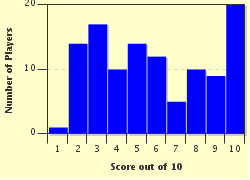Quiz Answer Key and Fun Facts
1. At rest, neurones must maintain a constant potential difference across their membranes. This is done by establishing a concentration gradient of ions. Which part of the plasma membrane is impermeable to ions, thus helping to maintain this gradient?
2. Ion concentrations either side of the cell membrane of neurones set up a resting potential, the exact value of which can be calculated using the Goldman voltage equation. According to this equation, which of the following is a cell's resting potential not dependent on?
3. A stimulus, whether it be physical or chemical, sends impulses to the cell body (or soma) of a neurone. Which type of fibre is used to transmit electrical signals between the receptor (which detects the stimulus) and the soma?
4. As electrical impulses travel towards the cell body, their signal decreases. To ensure that the signal is not lost, the cell body can be located closer to the stimulus (this is called spatial summation). Also, several signals may input into same cell body in a similar space of time. What is this type of summation called?
5. There are several inputs into the cell body - some are excitatory and some are inhibitory. The sum of these inputs determines whether the threshold potential will be reached (i.e. if an action potential will be fired). What name is given to the structure which defines the boundary between the cell body and the axon?
6. If inputs to the cell body of a neurone cause the cell to reach the threshold potential, an action potential is fired. This system ensures that every action potential is the same strength. How, then, do we distinguish between stimuli of different strengths?
7. Since axons must transmit information to all parts of the body, it is often necessary for them to be very long. Many axons are insulated by a myelin sheath, which reduces attenuation. What type of signal transmission, from the Latin meaning "to jump", is accommodated by this myelin sheath?
8. On the journey of an electrical impulse, it may have to cross a chemical synapse, which transmits information from one neurone to the next via a chemical neurotransmitter. However, there are also electrical synapses. Which of these is untrue of electrical synapses?
9. Once one section of the axon along which the impulse travels has been depolarized, it must repolarize. The exit of potassium ions from the neurone causes not only repolarization, but hyperpolarization, leading to an absolute refractory period. What is the major significance of this action?
10. After being initiated by a stimulus, electrical impulses are processed in the central nervous system (made up of the brain and spinal cord). The CNS then sends impulses of its own along neurones to structures which bring about an appropriate response to the stimulus. What general term is used for these structures, which include muscles and glands?
Source: Author
doublemm
This quiz was reviewed by FunTrivia editor
gtho4 before going online.
Any errors found in FunTrivia content are routinely corrected through our feedback system.


